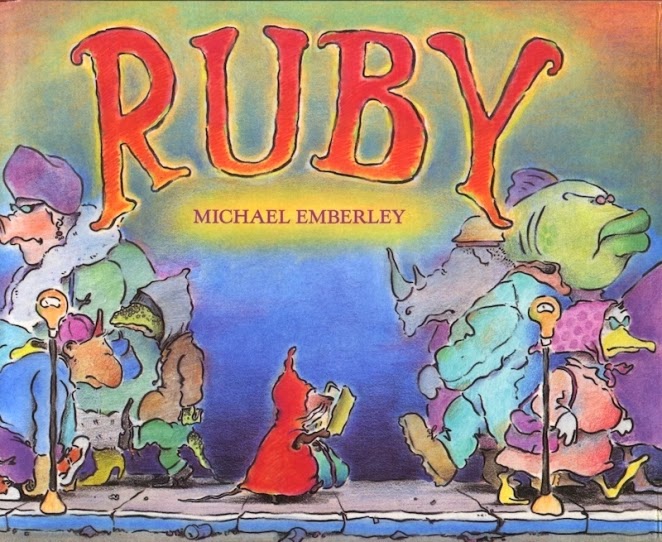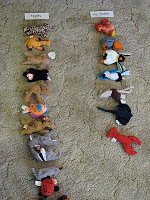With summer upon us, I couldn't resist pulling out Fractured Fairy Tales, my all-time favorite unit to teach. Three excited kiddos gather with the ultimate goal of writing and producing a fractured fairy tale play. Take a peek...
Getting Started
In the first two minutes of class, students make lists of every fairy tale they can recall. The highest recorded number? Six! I tell them they'll soon have a lot more! We do a little Round-Robin story telling of the Three Little Pigs, with a pantomime thrown in. They think they're hilarious. (They are right!)
I give them each a bibliography so that they can add titles & authors as they read. ...'Cause, whew...are they about to READ!!!!
Sorting and Reading
The team audibly gasps as they spot the selection of fairy tales. While I own a lot myself, I also add a generous selection from my local library.
[Note: For entertainment, after the unit, I counted. 82 of my books + 30 library books. And I didn't even begin to gather all that are available. Fractured fairy tales are one of the best reading hooks you can ever give a group of kids. Don't miss this opportunity!]
I challenge students to sort the books by individual story. So, for example, all the Red Riding Hood tales go into one bin, labeled with a sticky note. As children peruse the pile, they can also write their names on sticky notes and place them on the covers of books they want to revisit.
I plan on giving them 15-20 minutes to read. After 20 minutes, they beg for more. After 30, they beg for more. After 45, they concede to move on to the next part of the project.
Story Mapping
Next, these young writers spend a little time thinking about "What Makes a Good Story?" This is where a plot map comes in handy. We read Little Red Riding Hood together and talk about the points of action in the story, creating a plot map with rising action, climax, falling action, and conclusion. They love quantifying the level of excitement in each moment of the story.
At this point, we also refer to a Folk & Fairy Tale Characteristics poster as we consider, "What makes a fairy tale a fairy tale?"
Pre-Writing a Fractured Fairy Tale
We gather to create an anchor chart on concepts we could change to create Fractured Fairy Tales. As a group, students choose one particular tale to fracture, with the idea that the individual tales will eventually be combined into a group tale. By the time the chart is complete, students are bursting with ideas.
Using the anchor chart for support, they gather ideas on a Fractured Fairy Tale Think Sheet, and begin writing individual stories.
At this point they shock me again. I anticipate 20-30 minutes of uninterrupted writing. They beg to keep going...and going...and going. As students finish, they silently read from the giant stash of books. The final writer stops (after repeated pleas to continue!) after 60 minutes. Talk about perseverance!
Group Story Work Begins!
At this point, students meet to read their stories aloud to one another. Listeners ask authors to highlight portions of stories that they recommend for the group production.
Something from each person's story is highlighted--something about the setting, the dialogue, a character, a turn of phrase--something! Everyone's work is valued by the group.
Students then use a Fractured Fairy Tale Think Sheet in a group pre-write. After agreeing to basic content, they begin writing a group story. Each child is assigned a job, with jobs rotating every 5 minutes. With just three children in a group, jobs include: Manager, Time Keeper, and Scribe.
Group Scriptwriting
Without fail, students crazy-love this next part. Together, and using their group story as a backbone, they write a script on color-coded paper. This technique (my 20yo invention!) is fabulous as it allows students to easily revise. And revise. And revise. And did I mention...they LOVE IT!
Rehearse and Perform
And then, oh my--blocking the performance, choosing costumes, selecting the perfect stage, inviting the audience--endless fun! And of course, when it's summer, there is no better Rapunzel tower than the play structure.
As soon as the performance ended, this crew started debating which fairy tale they'll fracture next summer!
Want to get kids inspired to read, write, and act? Read more about the this unit on my blog. Or learn more about the entire Fairy Tale Lesson Plan Bundle (100+ pages of lesson plans, student handouts, photos, bibliographies, tips, and more!) by clicking here.


































